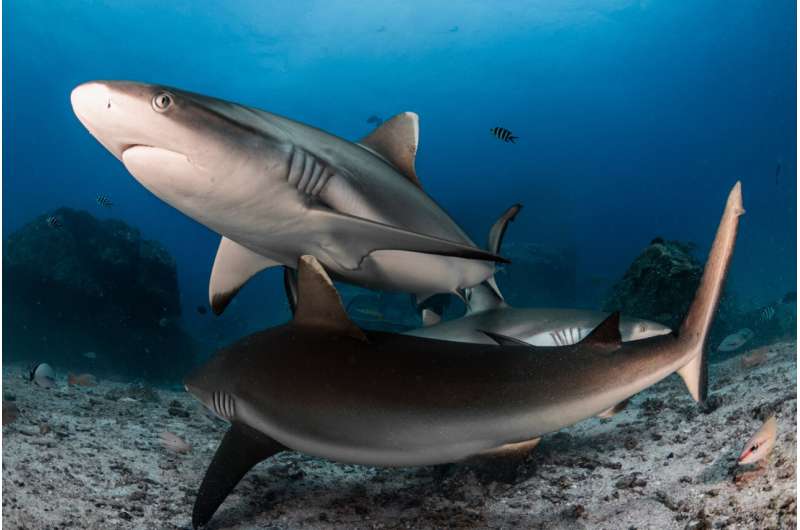This article has been reviewed according to Science X's editorial process and policies. Editors have highlighted the following attributes while ensuring the content's credibility:
fact-checked
peer-reviewed publication
proofread
Resting gray reef sharks change what we know about how they breathe

Predators in perpetual motion. Sleepless in our seas. If that's your image of sharks, you're not alone. And for good reason: sharks must swim to breathe (or so we were told). The science of how sharks sleep and breathe is linked, and while all sharks use gills to breathe, there are two ways that they move oxygen-rich sea water over those gills. Some sharks, called obligate ram ventilators, 'ram' oxygen-rich sea water over their gills and need to keep moving to do so. Other species, called buccal pumpers, actively pump sea water over their gills while stationary.
Science today tells us that sharks can be still—and some suggest that they sleep. But there is no solid evidence of sleep behavior in ram ventilators. Scientists have hypothesized that they don't sleep at all, or they sleep using half their brain (like sperm whales and bottlenose dolphins), or they sleep facing into ocean currents.
A new paper "Just keep swimming? Observations of resting behavior in gray reef sharks Carcharhinus amblyrhynchos (Bleeker, 1856)", published in Journal of Fish Biology upends what we know about one obligate ram ventilator. The gray reef shark is an Endangered reef dweller in the family Carcharhinidae and was the quintessential representative of a shark that moves to breathe.
"On routine survey dives around D'Arros we found gray reef sharks resting under coral reef ledges," says Dr. Robert Bullock, the director of research at the Save Our Seas D'Arros Research Centre (SOSF-DRC) in Seychelles. "This is not something we believed they could do. The gray reef shark has been considered a ram-ventilating species, unable to rest, so to find these ones resting turns our fundamental understanding of them on its head."
The researchers encountered gray reef sharks resting alone and in groups at different sites around Seychelles. And through it all, the sharks seemed blissfully unaware of their observers. It's a key observation: scientists think that increases in arousal thresholds count as the hallmark of sleep rather than just rest.
The sharks remained still, except for lower jaw movements that suggest these ram-ventilating sharks can switch to buccal pumping behavior. With little to no currents at the sites and sharks at rest facing in all directions, it seems the idea that the only way they'd rest is facing into currents holds little water for gray reef sharks.
Craig Foster, founder of the SeaChange Project, was one of the divers and authors of the paper. "There is something very special," he says, "about 'tiptoeing' around underwater at a depth of 25 meters and looking into the open eyes of sleeping sharks, moving carefully so as not to wake the peaceful beauties."
"I love things that challenge our current thinking, and I've always thought of the gray reef shark as a clear example of a species that needs to swim to breathe. Clearly not from this discovery."
Dr. James Lea, the CEO of the Save Our Seas Foundation, is enthusiastic about what the paper portends. "This raises all kinds of other questions," he declares. "How are they coping? How long for? How often? We have so much to learn still, and to me, that's exciting."
If the gray reef shark can switch its mode of breathing and rest, there's more to uncover about similar sharks. "It's key to understanding how they use their environment and also how this may change in response to shifts in environmental conditions," explains Dr. Lea. "How important is this rest, or possible sleep, for the sharks? And what's the impact on them if they can't get that rest if conditions change, such as oxygen levels rising or falling due to a changing climate?"
The authors all agree that this discovery also says a lot about our own relationship with the natural world. "I hope that these findings serve as a reminder of how much we still do not know and how exciting that is. Science is about being wrong quite a lot. And that's okay," reflects Dr. Bullock.
Foster believes that what we know about the wild is critical to conservation. "Knowing how our shark kin sleep is to be closer to their fascinating world and to wake up from our own slumber and realize we cannot live without these magnificent marine beings," he states.
More information: Robert W. Bullock et al, Just keep swimming? Observations of resting behavior in gray reef sharks Carcharhinus amblyrhynchos (Bleeker, 1856), Journal of Fish Biology (2023). DOI: 10.1111/jfb.15623
Journal information: Journal of Fish Biology
Provided by Save Our Seas Foundation



















